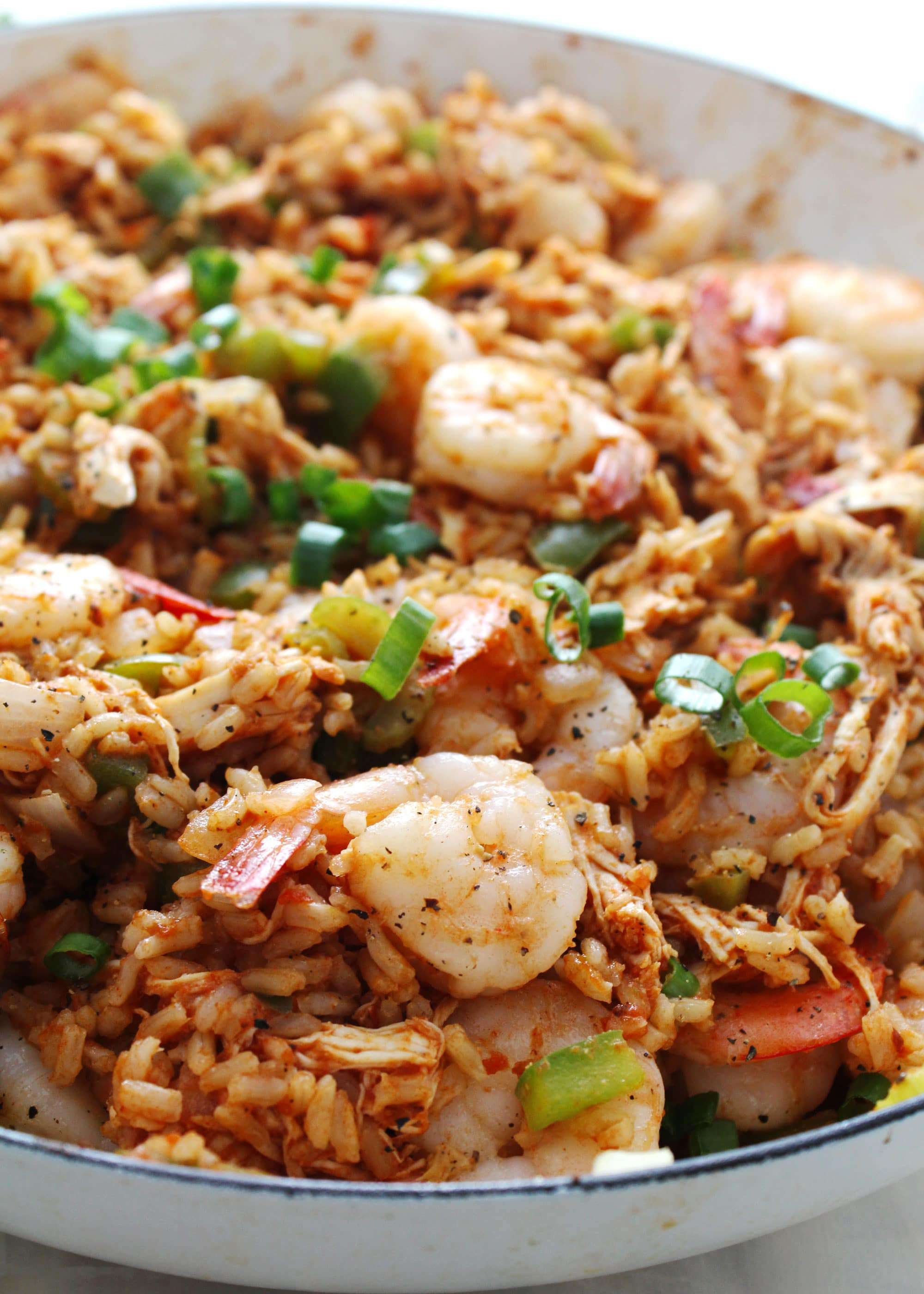Jambalaya
A one-pot supper from the bayou regions of Louisiana, this is the Creole version of Chicken & Shrimp Jambalaya made with tomatoes, and milder in flavor than its Cajun cousin.
Fat Tuesday, the last day of Mardi Gras in New Orleans. is the final day of enjoying excess and debauchery before one is supposed to atone for one's sins during the onset of Lent and Ash Wednesday. Or so the Roman Catholics believe. Be that as it may, it seems totally in character to enjoy a good, hearty Jambalaya for dinner on Fat Tuesday regardless of whatever you do the next day. Personally, I'll go with debauchery over atonement any day, and this recipe guarantees leftovers.
There is some mystery surrounding the origin of Jambalaya, including its name. One college of thought says the word is from Old French Provençal, jambalaia, meaning a "mish-mash" or "mix-up." The English word "jumbled" sounds like an approximation of that, so that might be true.
Another theory says that the word came from a contraction of Cajun French, jambon à la yaya, meaning "ham with rice." This could be true, too. It is thought that Jambalaya has its roots in the Spanish recipe for Paella, a rice dish often made with pork.
But for sure, the dish evolved in the bayou regions of the deep south and found its way to New Orleans if it did not, in fact, originate there. That is also up for debate, however, because it is a matter of historical fact that the first known, printed recipe for "Jam Bolaya" (as it was written), was published in 1878 in a church-sponsored cookbook in Mobile, Alabama.
Today, Jambalaya has varied preparations and there is no one, definitive Jambalaya recipe, except that it will almost always start with the "Holy Trinity" of Cajun and Creole cooking: onion, green bell pepper and celery. Along with rice, meat or seafood of varying kinds are added with spices and seasonings, and the dish will almost always contain Andouille sausage, a staple of Louisiana cooking. Generally, Jambalaya will fall into two categories: Creole or New Orleans style, and Cajun or Arcadian style. My recipe is the former, the primary difference being that it is less spicy than its Cajun cousin and only the Creole style of Jambalaya include tomatoes.
Jambalaya certainly is distinctly different from other famous New Orleans dishes like Gumbo, Étouffée or Shrimp Creole in that rice is cooked into the dish rather than served separately. Hence, it is a one-pot dinner, but pairs exceptionally with a loaf of garlic bread, a hearty salad with peppers and cheese, dressed with the Kitchen Tapestry recipe for Cajun Vinaigrette.
Plus, if it’s Fat Tuesday, a few Cajun martinis.
The Cajun Martini
My first encounter with Tomolives, a tart, pickled small green tomato, was in the mid-1990s at NOLA Restaurant in New Orleans before anyone on a national scale knew who Emeril Lagasse was. The restaurant bar boasted a Cajun Martini made thusly. NOLA was a terrific restaurant back then, busy to be sure, but not the touristy hot spot it later became, riding on its former culinary glory.
Ingredients
4 oz London Dry Gin (like, Bombay Sapphire)
spritz of dry vermouth
4 drops Tabasco Sauce
2 skewered Tomolives for garnish
Instructions
Spritz a chilled martini glass with the vermouth.
Pour the gin into a cocktail shaker and add hard ice.
Shake vigorously 29 times.
Strain the potion into the martini glass and garnish with the Tomolives.
Laissez les bons temps rouler!
Jambalaya

Ingredients
- 4 tbsp olive oil, plus 1 more
- 4 links Andouille sausage, sliced into 1/2-inch thick "coins"
- 6 boneless-skinless chicken thighs, cut into 1-inch cubes
- 1 large yellow onion, diced
- 4 stalks celery, diced
- 1 large green bell pepper, diced
- 3 cloves garlic, minced
- 3 cups uncooked long-grain rice
- 2 14.5-oz cans petite diced tomatoes (like, Hunt's)
- 4 cups chicken stock (like, Swanson's or Kitchen Basics)
- 1 14.5-oz can chicken broth (like, Swanson's)
- 3 tbsp tomato paste (like, Cento)
- 2 tbsp dried thyme
- 2 bay leaves
- 1 lb jumbo shrimp, peeled, de-veined and tails removed
- 1 tsp smoked salt (like, San Francisco Salt Company Alder Wood)
- 1 tsp Worcestershire black pepper (like, McCormick)
- 1 tsp Hungarian style paprika
- ½ tsp cayenne pepper
- ½ cup fresh parsley, finely chopped
- 4 green onions, chopped
Instructions
- In a large Dutch oven or stock pot that has a tight fitting lid, heat the 4 tbsp of olive oil over medium high heat; add the sausage and chicken, and cook about 5 minutes or until the chicken is opaque and the sausage is beginning to brown.
- Add the onion, celery, and bell pepper. Cook about 10 minutes, stirring frequently, until the vegetables are tender and the onions are translucent.
- Add garlic, stirring for about 30 seconds until fragrant.
- Add the rice, and stir about 3 minutes until lightly toasted.
- Add the tomatoes, chicken stock, chicken broth, thyme, smoked salt, black pepper and bay leaves. Bring to a boil, then add the tomato paste. Stir well to combine, then reduce heat to medium-low.
- Cover, and cook for 30-40 minutes until the rice is tender. If more liquid is required, add a bit of water. Once the rice has absorbed its liquid, you want the Jambalaya to be moist but not soupy.
- In a mixing bowl, combine 1 tbsp of olive oil with the shrimp and stir to coat. Add the paprika, cayenne, and parsley and stir to coat again.
- Add the shrimp to rice mixture, and stir until combined. Cook for another 3-4 minutes or until shrimp turn pink.
- Serve in large soup bowls and garnish with the chopped green onion.


